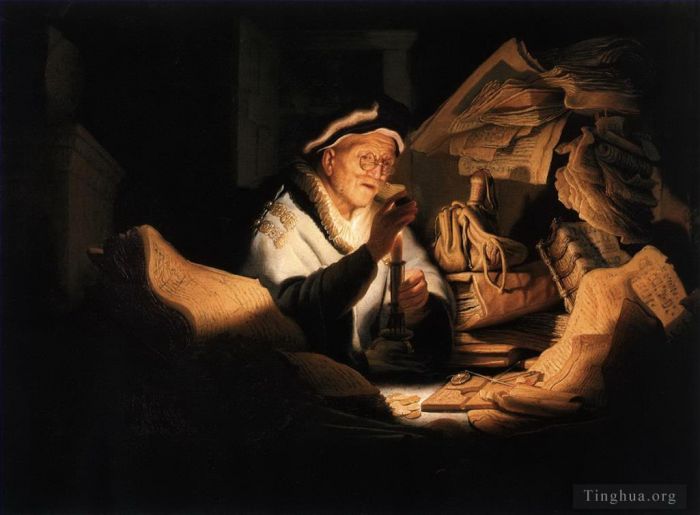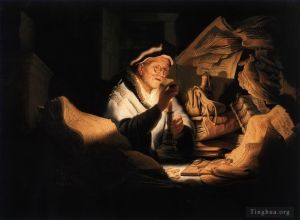The Parable of the Rich Fool (The Rich Man from the Parable)
Rembrandt
- Price: Price on Request
- Art Type: Oil Painting
- Size:
- English Comments: 0
- International Comments: 0
- Creating Date:
- Introduction and Works of Rembrandt >>
Work Overview
- The Parable of the Rich Fool (The Rich Man from the Parable)
Rembrandt
Date: 1627
Style: Baroque
Genre: genre painting
Media: oil
Dimensions: 43 x 32 cm
The Parable of the Rich Fool is a parable of Jesus which appears in Luke 12:13-21. It reflects the foolishness of attaching too much importance to wealth.
The parable has been depicted by artists such as Rembrandt.
The parable is introduced by an audience member who tries to enlist Jesus' help in a family financial dispute:[1]
One of the multitude said to him, "Teacher, tell my brother to divide the inheritance with me." But he said to him, "Man, who made me a judge or an arbitrator over you?" He said to them, "Beware! Keep yourselves from covetousness, for a man's life doesn't consist of the abundance of the things which he possesses."
— Luke 12:13-15, World English Bible
Jesus then responds with the parable:
He spoke a parable to them, saying, "The ground of a certain rich man brought forth abundantly. He reasoned within himself, saying, 'What will I do, because I don't have room to store my crops?' He said, 'This is what I will do. I will pull down my barns, and build bigger ones, and there I will store all my grain and my goods. I will tell my soul, "Soul, you have many goods laid up for many years. Take your ease, eat, drink, be merry."' "But God said to him, 'You foolish one, tonight your soul is required of you. The things which you have prepared—whose will they be?' So is he who lays up treasure for himself, and is not rich toward God."
— Luke 12:16-21, World English Bible
The rich farmer in this parable is portrayed negatively, as an example of greed.[1] By replacing his existing barn, he avoids using agricultural land for storage purposes, thus maximising his income, as well as allowing him to wait for a price increase before selling.[1] St. Augustine comments that the farmer was "planning to fill his soul with excessive and unnecessary feasting and was proudly disregarding all those empty bellies of the poor. He did not realize that the bellies of the poor were much safer storerooms than his barns."[2]
The farmer's conversation with his wife is, in Luke's gospel, a negative.[1] It is also self-centred: first-person pronouns occur 11 times.[3] Arland J. Hultgren comments that the parable "provides an example of what one ought not to be like. The person whose identity is tied up with his or her possessions, status, and/or achievements — and is driven by acquiring them — can so easily end up unaware of the call of God and the need of the neighbor."[3]
The farmer's foolishness lies particularly in the fact that wealth cannot guarantee the future: the Day of Judgment arrives sooner than he expects.
This parable has been depicted by several artists, including Rembrandt, Jan Luyken, James Tissot, and David Teniers the Younger.
The painting, known as The Money-Changer, is also interpreted as the allegory of miserliness.
Rembrandt's work is imbued with certain qualities we can call Caravaggesque even if they are not directly derived from the Italian master's work. The highly conscious use of dark and light in constructing compositions is considered part of Caravaggio's legacy. This method was known to Rembrandt through the mediation of Utrecht painters like Gerrit van Honthorst, who brought stylistic Caravaggism from Italy to Holland.
Rembrandt illustrates the parable of the rich fool, as told in Luke 12. At night a rich man studies one of his golden coins.
In the early 17th century a stack of books was often used as a symbol of vanity. The Hebrew letters suggest a biblical setting.
The usual interpretation of the parable is that there is no point in spending a life gathering wealth. After all, onced you die money is of no use. It might even get into the hands of people who do not deserve it. It is therefore thought to be wiser to be "rich toward God".
- Copyright Statement:
All the reproduction of any forms about this work unauthorized by Singing Palette including images, texts and so on will be deemed to be violating the Copyright Laws.
To cite this webpage, please link back here.
- >> English Comments
- >> Chinese Comments
- >> French Comments
- >> German Comments
- >>Report
- Bathsheba at Her Bath
- The Return of the Prodigal Son
- Balaam and the Ass
- Stormy Landscape
- Christ driving the moneychangers from the temple 1626
- Young Man At His Desk
- Haesje
- St Paul at his WritingDesk
- The Abduction Of Ganymede
- Self Portrait at an Early Age 1628
- Woman in bed
- History Painting
- David and Uriah
- The Blinding of Samson
- Susanna
- Portrait Of Joris De Caullery
- Portrait of Nicolaes Ruts
- Flora
- Christ In The Storm On The Sea Of Galilee
- The beheading of john the baptist
- The Toilet of Bathsheba
- Susanna and the Elders
- Saskia in Pompous Dress
- Anna and the Blind Tobit
- Samson And Delilah
- Saskia Laughing
- Cupid Blowing Soap Bubbles
- Dead peacocks
- Self Portrait 1659
- The Holy Family with Angels
- The Artists Son Titus
- The denial of peter 1660
- The Baptism Of The Eunuch
- Repentant Judas Returning The Pieces Of Silver
- Portrait of the Artist at His Easel 1660
- Self Portrait as a Young Man 1634
- Young Woman Trying Earrings
- The Stoning Of St Stephen 1625
- Portrait Of An Eighty Three Year Old Woman
- Christ and the Woman Taken in Adultery
- Self-portrait as the Apostle Paul
- Musical Allegory
- The Artist In His Studio
- Maria Trip
- Man In Oriental Dress
- Titus at his desk
- Self portrait 1628
- The Polish Rider
- Agatha Bas
- Adoration of the Shepherds
- Young Man
- The Mennonite Minister Cornelis Claesz Anslo in Conversation with his Wife Aaltje
- Frederick Rihel on Horseback
- David Playing The Harp To Saul
- Portrait of Maria Trip 1639
- Portrait Of Amalia Van Solms
- Portrait Of A Young Woman With A Fan
- The holy family night
- The Elevation Of The Cross
- Jan Rijcksen And His Wife
- Holy Family
- Abraham of Isaac (The Angel Stopping Abraham from Sacrificing Isaac)
- The Mill
- The Risen Christ Appearing to Mary Magdalen
- The Ascension Of Christ
- Portrait of Saskia van Uylenburgh
- Self Portrait 1658
- Elder
- Portrait of Haesje van Cleyburgh
- Saul and David
- Landscape with the Rest on the Flight into Egypt
- The Conspiration of the Bataves
- Self portrait Det
- Portrait Of A Man
- The Holy Family
- Self
- Christ and St Mary Magdalene at the Tomb
- Joseph Accused by Potiphars Wife
- Artemisia
- Supper at Emmaus
- Christ Driving The Money Changers From The Temple
- The Prodigal Son in the Brothel (Rembrandt and Saskia in the Scene of the Prodigal Son in the Tavern)
- Sampling Officials of the DrapersGuild
- Danaë
- Winter Landscape
- Johannes
- JohDet
- Dr Ephraim Bueno Jewish Physician and Writer
- Saskia
- Self Portrait 1660
- Titus van Rijn in a Monks Habit
- Apostle Paul
- Samson at the Wedding
- St John The Baptist Preaching
- Portrait of Maria Trip
- The Night Watch
- Descent from the Cross
- Self Portrait 1669
- Portrait of Saskia with a Flower
- The Prophetess Anna known ass Mother
- The Man with the Golden Helmet
- David and Jonathan
- The Archangel Leaving the Family of Tobias
- Rape of Proserpina
- Portrait Of Maerten Soolmans
- Jeremiah Lamenting the Destruction of Jerusalem
- The Jewish Bride
- Christ on the cross 1631
- The Stone Bridge 1638
- Diana Bathing With The Stories Of Actaeon And Callisto
- Philosopher Reading
- Portrait Of A Woman
- The Anatomy Lesson of Dr Nicolaes Tulp
- Tobit and Anna with the Kid
- Peter Denouncing Christ
- Girl at a Window (Girl Leaning on a Stone Window Sill)
- The Raising of Lazarus
- Saskia Wearing A Veil
- Saskia As Flora
- The Visitation
- The Parable of the Rich Fool (The Rich Man from the Parable)
- Family Group
- Joseph Dream in the Stable in Bethlehem
- The Holy Family with a Curtain
- Deposition from the Cross
- Portrait Of An Old Man
- Self Portrait In A Gorget
- Portrait Of Alijdt Adriaensdr
- Slaughtered Ox (Flayed Ox or Side of Beef or Carcass of Beef)
- Portrait of Nicolaas van Bambeeck
- Portrait Of The Artist In A Flat Cap
- Philosopher in Meditation
- Self Portrait In A Plumed Hat
- The Incredulity of St Thomas
- Self Portrait 1629
- Self Portrait as the Apostle St Paul
- Two Old Men Disputing
- Aristotle with a Bust of Homer
- Belshazzars Feast
- Hendrickje Bathing in a River
- Portrait Of Maria Bockenolle
- Jacob
- Landscape with a Castle
- Portrait of Johannes Wtenbogaert
- Evangelist Matthew
- Self portrait 1632
- Portrait of a bearded man
- Self portrait 1640
- Jacob Blessing the Children of Joseph
- Portrait of a man in military costume
- The Dream of St Joseph
- Hendrickje Slapend RJM
- Portrait of Willem Bartholsz Ruyter
- In Velvet Cap and Plume SIL
- The Sense Of Sight
- Abraham Entertaining the Angels SIL
- Portrait of Willem Bartholsz Ruyter RJM
- Self Portrait 16289
- Sakia Asleep In Bed
- Study from the Nude Man Seated before a Curtain SIL
- The Blindness of Tobit SIL
- Drawing at a window
- Portrait Of Cornelis Claesz 1640
- Saskia In A Straw Hat
- Self Portrait Staring
- The Artists Father
- Ephraim Bonus Jewish Physician SIL









 Singing Palette
Singing Palette